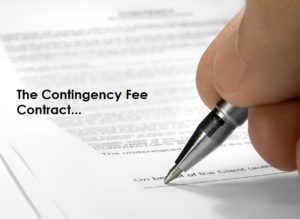HOW MUCH SHOULD YOUR ACCIDENT LAWYER COST?
We have to pay for things every day. Plumbing breaks. Electricity fizzles in houses. Luckily, most of us do not experience frequent injury accidents. Handling injury accidents requires the expertise of an injury accident lawyer. Accident attorneys do not volunteer, but are paid. This article informs on how these lawyers are paid, the amounts, what is, and what is not reasonable.
THE OPTIONS: CONTINGENCY FEE VS. ATTORNEY FEE AWARDS VS. HOURLY
The Hourly Rate Method of Paying a Lawyer

There are three main ways on which attorneys are paid. The most common is an hourly rate. Hourly rates are determined by the amount per hour the attorney charges and the amount of time he spends. The more he works, the more you pay. Hourly attorneys will keep detailed records of exactly what they are doing and how long they are spending on a particular task. You should receive a monthly statement. That monthly statement will indicate the hourly rate and break down (typically in six minute intervals) what the attorney was doing and why he was doing it.
Rates for attorneys vary between $150 per hour and $500 per hour. How much an attorney charges hourly is based entirely upon what people will pay for his services. Shopping around can save significant money here. However, remember, the best attorneys are paid more for a reason. It is often financially better to hire the more expensive attorney and get the better result.
Remember also, you are paying the attorney for keeping close track of his time, which will be included in the hourly fee. Hourly pay is common for attorneys and clients who regularly work together. It is common for an hourly attorney to require a “retainer; an amount of money paid in advance to put towards the hourly fee.
Paying through an Attorney’s Fee Award Case
 Sometimes you do not have to directly pay the lawyer at all. Certain types of cases (like vexatious refusal to pay by insurance) carry with them awards of attorney fees. This means at the end of the case, if you win, the other side pays for your attorney’s fees.
Sometimes you do not have to directly pay the lawyer at all. Certain types of cases (like vexatious refusal to pay by insurance) carry with them awards of attorney fees. This means at the end of the case, if you win, the other side pays for your attorney’s fees.
One would want to check with their particular jurisdiction and particular case type to determine whether an attorney’s fee awards can be expected. Few cases invoke statutes where attorney’s fees are mandated.
You should be able to understand the contract your own lawyer gives you. The vast majority of contingency fee lawyers contracts are pages long, with lots of fine print. Many have “tiered” results, with different payment amounts being paid based upon how far the legal claim proceeds. This, however, is unnecessary. For example, the contingency fee contracts my offices uses for personal injury and wrongful death cases, contains ONLY the following language:
I, We, _____________, hereby employ Matt Hamilton, Hamilton & Associates, Lawyers as my attorney to represent me in my claim against _________________, and all other persons considered liable by said attorney for personal injuries sustained by me on the ______ day of ________. It is agreed that said attorney shall receive ______ percent of whatever is realized on said claim for his services. Client agrees to pay for expenses incurred in pursuing the claim. Signed ______________.
Sometimes, simpler is better.
The British System Versus the American System of Paying Lawyers
There is an old philosophical difference between British law and American law. In the British model, the losing side always pays for the other person’s attorney’s fees. In the American model, typically each party (whether they win or lose) pays for their own attorney’s fees. The American model is preferred because it gives an advantage to the ordinary person who is the victim. Often, corporations will pay tens or hundreds of thousands of dollars to their attorney. This would mean that a person simply could not afford to take the risk of suing a large corporation and incur that level of expense under the British model.
Paying the Lawyers through a Contingency Fee
The contingency fee is the most common reimbursement for accident injury lawsuits. The contingency fee is governed by state law. In it, the attorney takes a percentage of the win; however large or small that may be. The attorney takes a considerable risk by fronting the expenses. He advances his efforts in hopes of winning. If the case loses, the attorney gets nothing, and loses his cost and time. If the case wins, the attorney gets a generous reward. Each attorney must take multiple cases in order to justify the risk of being paid through a contingency fee.
Complaints About High Pay Low Effort Contingency Fees
Sometimes clients complain about the generosity of contingency fee versus the amount of time their attorney has spent on it. This attitude presumes all cases will win. It also does not take in account the risks and efforts of the attorney. Lastly, there is the considerable time, training, and monetary investment for the attorney to get his skills to the level to allow for victory.
Contingency Fees are Sometimes Prohibited
Rule 4-1.5 (c) and Rule 4-1.5 (d) of the Supreme Court of Missouri prohibits contingency fees in certain types of cases. For example, family law and divorce cases cannot have contingency fees.
How Long is the Attorney Required to Work on a Contingency Fee Case?
The Supreme Court of Missouri in the case of In re Crews, 159 S.W. 3d 355 (Mo. 2005) speaks to this issue. The Supreme Court of Missouri ruled that it is presumed in an attorney contingency fee agreement that the attorney must represent that party through judgment.
This means if an appeal should be attempted after a judgment, a separate agreement should be reached. Naturally, contingency fee agreements are creatures of contract. The parties can agree to whatever specifics they may want if it expressed in the contract.
When is an Attorney’s Fee Unfair?
The Missouri Supreme Court in the case of Murphy v. Dalton, 314 S.W. 2d 726, 733 (Mo. 1958), spoke to the issue of fairness in contingency fee contracts. These include injury cases and accident cases. In Murphy, the Supreme Court ordered that every contingency fee contract must be viewed from the point and time and under the circumstances of the parties at the time of the execution of the contract. This means if circumstances later change, that does not matter. If certainty or uncertainty change later on that is not taken into account.
Neither the attorney nor the client can view in retrospect (after the fact) regarding the success or failure of the case to determine whether the contingency fee is reasonable. For example, if both parties are expecting long and drawn out litigation, a jury trial, and perhaps even an appeal, and signed a large contingency fee, the attorney cannot later complain. On the opposite side of the scale, if the case settles after a simple one page demand letter, the client can no longer complain. If ten years or fifteen years of litigation ensues and hundreds of thousands of dollars in expenses are incurred the attorney cannot later complain that he should have been paid more. The reasonableness of a contingency fee is taken at the time that the paper is signed.
WHAT ARE TYPICAL CONTINGENCY FEE AMOUNTS?
 Like stairs, contingency fee amounts typically go up in steps.
Like stairs, contingency fee amounts typically go up in steps.
Thirty Three Percent (33%) Contingency Fees
A one third contingency fee was once common and nearly ubiquitous. Almost all accident and injury lawsuits were signed up for a one third contingency fee. This was through the mid-90s. The philosophy was that one third went to the lawyer, one third went to the victim, and one third paid for past medical and other expenses.
In practice, this was never true. Some cases had large values and required small amounts of work. Other cases presented large amounts of work and small value. “Tort Reform” in the early 2000s vastly increased the cost of doing litigation and increased the cost of making claims for innocent victims. Many attorneys went out of business. The surviving law firms had to change, adapt, and improve, just to make less money. The cost of bringing lawsuits increased substantially. More experts are now needed. This requires greater expenses. One third contingency fees are still common. However, do not expect to get that amount as an offer from the attorney. Those are only when competition is high or the value of the case is high with little work.
Forty Percent (40%) Contingency Fees
Forty percent of the total take on the case (not counting expenses) is common nowadays. This accounts for the increased cost and expertise needed to be victorious in litigation.
Forty Five Percent (45%) Contingency Fees and Higher
Contingency fee agreements where the attorney takes forty-five percent or more of the take are uncommon. Typically, one will see this in strict product liability product defect cases and manufacturing defect cases. Medical malpractice and other professional liability cases also can carry contingency fee agreements of this high percentage. These higher fees are to offset the increased litigation costs (sometimes hundreds of thousands of dollars) and the risky of the case.
WHY SHOULD I PAY SO MUCH FOR A CONTINGENCY FEE LAWYER?
There is an old expression as a joke for divorces. The joke goes; “Why are divorces so expensive? Because they are worth it.” The opposite is true (with the same rational) in contingency fee cases. Simply put, the client gets more money at the end of the case, does less work, and has fewer headaches on average with a competent contingency fee lawyer working on their case compared to handling it on their own. High priced contingency fee lawyers tend to get better results and tend to get more money for their clients. In short, contingency fees are expensive because they are worth the investment.
Author:
Matt Hamilton of Hamilton & Associates, Lawyers
- Juris Doctor
- Trial Attorney


